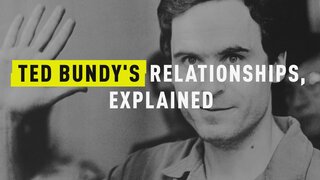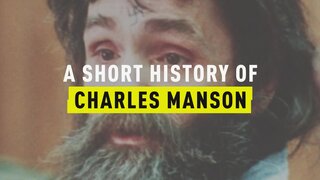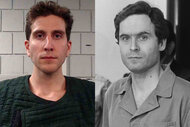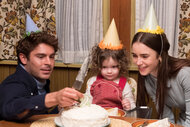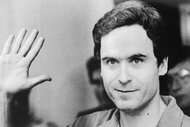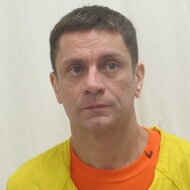Create a free profile to get unlimited access to exclusive videos, breaking news, sweepstakes, and more!
Who Was Ted Bundy? Everything You Need To Know About The Twisted, 'Charming' Serial Killer
In his later confessions, Bundy said he engaged in necrophilia and that he shampooed the hair of one victim and applied makeup to another, both post-mortem.
One of the most notorious serial killers in America, Ted Bundy was known for charming his young female victims into complacency before brutally assaulting and murdering them. Though he killed at least 30 women, Bundy went relatively unnoticed until August 16, 1975, when a routine traffic stop led to the discovery of multiple suspicious items, including pantyhose, a ski mask, a crowbar, an ice pick and handcuffs. He soon became a suspect in murders across the US, and his eventual trial in June 1979 was the first to ever be televised nationally in the US.
Bundy was born Theodore Robert Cowell on November 24, 1946, in Burlington, Vermont, at an unwed mothers’ home. His mother was 22-year-old Eleanor Cowell, and to this day, the identity of his father has never been known for certain. Growing up, Bundy lived in Philadelphia with his aunts and grandparents, whom he used to believe were his parents. As a child, Bundy appeared completely normal — for the most part. According to investigative journalist Kevin Sullivan, there is one moment from Bundy’s childhood that foreshadowed his future as a serial killer.
Sullivan told Oxygen’s “Snapped Notorious,” “It has been reported that one of the aunts woke up one morning, and Ted had taken kitchen knives and placed them pointing at her on the bed. That’s the first sign we have that something might be wrong with the child.”
In 1950, Bundy and his birth mother moved to Tacoma, Washington, where she married a man named Johnnie Culpepper Bundy, who adopted young Ted. They went on to have four children of their own. Bundy said he grew up “with two dedicated and loving parents” in a Christian home with “no drinking, smoking, gambling, fighting or physical abuse.”
But as a teenager, Bundy became enamored by detective magazines that were “full of stories of violent crime and how to get away with it,” according to FBI profiler Bill Hagmaier. A psychologist who evaluated Bundy told “Snapped Notorious” that he experienced “a lot of sexual relieving through the fictional stories.” Bundy also disclosed in later interviews that his exposure to these magazines led him to seek out “violent pornography and ‘more potent, more explicit, more graphic kinds of material,’” according to The Los Angeles Times.
[Photo: Getty Images]
Around this time, Bundy was twice arrested on suspicion of burglary and auto theft, but the details of both cases were expunged from his record when he turned 18. Aside from these minor run-ins with the law, Bundy was described as a “good-looking socializer” by his high school friends. Teachers remembered him as a “model student.”
After graduating from high school in 1965, Bundy drifted between different colleges before enrolling at the University of Washington. A “shy” student, Bundy was insecure about his lower-middle class upbringing and believed he had “nothing to offer” his peers. But in 1967, Bundy met a fellow UW student. She had grown up in a wealthy, successful family in California, which Bundy desperately wanted to be part of. The two dated for less than a year, and then she broke off their relationship because she believed Bundy was directionless and “unsure of himself.”
A detective told “Snapped Notorious,” that "he was devastated by the breakup,” and her “rejection was a huge blow to Ted Bundy’s ego.” Many believe her rebuff may have triggered Bundy’s murder spree and possibly motivated him to target women who looked similar to her. A detective told “Snapped Notorious,” that she was “bright and beautiful. She had long brown hair, and she was the spitting image of almost all of Ted Bundy’s victims.”
But in 1969, Bundy seemed to have moved on and started dating a new woman, who was a young mother and divorcee. Along with taking classes and hanging out with his new girlfriend, Bundy become involved in politics and volunteered for Republican presidential nominee Nelson Rockefeller. He also worked at a Seattle suicide prevention hotline, where he met and worked with Ann Rule, a former police officer and aspiring crime writer. In her book “The Stranger Beside Me,” Rule described Bundy as “kind,” “solicitous” of her safety and “seemingly empathetic.
In 1972, Bundy graduated from UW, making the honor roll. The next year, he was accepted into law school at the University of Puget Sound.
The First Murders
Continuing in politics, Bundy worked on the committee for Republican Governor Daniel J. Evans' re-election campaign. Bundy was tasked with “keeping tabs” on Evans’ opponent, and he posed as a college student and shadowed him to collect intel. When Evans won the election, Bundy was appointed as the special assistant for state Republican Chairman Ross Davis.
In the summer of 1973, Bundy went on a business trip to California for the Washington Republican Party. Though still in a relationship with his girlfriend, he reached out to his college sweetheart, who had broken his heart. She was “amazed at the changes” he had made after their breakup.
Impressed by the new Ted, his college girlfriend was happy to rekindle their relationship, and she flew up to Seattle several times to visit Bundy. During one trip, Bundy took her dinner at the Davis family’s home, and he introduced her as his fiancee. He soon discussed plans of marriage.
But in January of 1974, Bundy abruptly broke off contact with his college girlfriend, and he stopped responding to her calls and letters. A month later, she finally got ahold of him. She asked why he had suddenly ended their relationship, and he very calmly responded, “I have no idea what you mean.” That was the last time they spoke.
She came to the realization that Bundy had plotted this rejection from the start of their renewed relationship. According to “The Stranger Beside Me,” Bundy “had waited all those years to be in a position where he could make her fall in love with him, just so that he could drop her, reject her, as she had rejected him.”
Back in Seattle, Bundy had dropped out of law school and was working as the assistant director of the Seattle Crime Prevention Advisory. According to The New York Times, he wrote a rape-prevention pamphlet for women while working there. Even more disturbing, Rule recalled that around this time, she ran into Bundy and he asked her for “some back copies of the stories [she’d] done on rape cases.”
Bundy explained, “I’m doing a study on rape victims. [...] It would help my research.”
Though it is debated when Bundy began killing, Bundy carried out the first murder that police can conclusively attribute to him in 1974, shortly after his final breakup with his college girlfriend. On January 4, Bundy broke into the apartment of 18-year-old University of Washington student Karen Sparks.
Bundy beat her close to death with a metal rod, which he also used to sexually assault her. She survived with permanent disabilities.
Less than a month later, he broke into the basement apartment of another UW student, 21-year-old Lynda Ann Healy, whom he beat, abducted and murdered. On March 12, 1974, 19-year-old Donna Gail Manson left her Evergreen State College dorm room to attend a campus jazz concert when Bundy abducted and murdered her.
Bundy’s fourth victim was 18-year-old Central Washington University student Susan Rancourt. Bundy lured Rancourt to his Volkswagen Beetle by wearing a sling and asking her for help moving some books. Two female Central Washington students later came forward to report that they had also been approached by a man calling himself “Ted.”
Roberta Kathleen Parks, 20, was abducted from Oregon State University on May 6 and bludgeoned the death. Bundy’s sixth victim, 22-year-old Brenda Ball, was kidnapped after leaving a Seattle tavern to look for a ride on June 1. On June 11, 18-year-old University of Washington student Georgann Hawkins was abducted while walking the one block between her boyfriend’s dormitory and her sorority house.
[Photo: Oxygen]
Bundy’s Later Murders
On July 14, 1974, Bundy approached 23-year-old Janice Ott at Lake Sammamish State Park. He apparently asked for her help unloading a sailboat from his Volkswagen Beetle, as his arm was in a sling. He then abducted and murdered her. Hours later, Bundy came up to 19-year-old Denise Naslund in the parking lot — again wearing a sling — and asked her for help. She was never seen again.
According to multiple witnesses, both Ott and Naslund were seen talking with a man who identified himself as “Ted.” Another witness also reported seeing a car that was later associated with Bundy — a tan Volkswagen bug. As news of the Washington disappearances spread, police released a composite sketch and details of the suspect, including a description of his car. Thousands of tips poured in about “Ted” and his tan Volkswagen.
At this point, Bundy had found a new job — working at the Washington State Department of Emergency Services. According to “The Stranger Beside Me,” Bundy’s co-workers had mixed feelings about him. Some liked him, while others thought he was a slacker and manipulator. Often, he wouldn’t show up for work and didn’t bother to tell his managers.
On one occasion, Bundy was out “sick” from July 11 to July 17. When police announced the disappearances of Ott and Naslund, Bundy’s colleague and friend Carole Ann Boone teased him “unmercifully.” According to “The Stranger Beside Me,” the head of the Search and Rescue group for Washington State also joked about Bundy “being a ‘look-alike’ for the ‘Ted’ the police were looking for.”
While they had no idea Bundy was actually responsible for the murders, four other people close to Bundy reported him to police as a possible suspect. A professor from the University of Washington, his girlfriend, an employee from the Department of Emergency Services and Ann Rule all said they knew someone named “Ted” who matched the composite sketch and drove a tan Volkswagen Beetle. Investigative journalist Kevin Sullivan told “Snapped Notorious” that although Bundy was being looked at by police, he appeared “so normal” that he didn’t really seem like the type of person who would be “a vicious killer.” He was never questioned by police.
In August of 1974, Bundy moved to Salt Lake City to attend the University of Utah Law School. That September, the remains of Ott and Naslund were were found near Lake Sammamish in a wooded area later dubbed the Issaquah dump site. From his new base in Salt Lake City, Bundy began killing again in the fall of 1974. On October 18, Bundy abducted, raped and strangled 17-year-old Melissa Smith, the daughter of a chief of police in Utah. He kidnapped, raped and strangled 17-year-old Laura Ann Aime on Halloween night.
On November 8, Bundy approached 18-year-old Carol DaRonch at a mall in Murray, Utah, and identified himself as a cop, “Officer Roseland.” According to The Los Angeles Times, Bundy told DaRonch her car had been broken into and that she needed to accompany him in his Volkswagen to the police station. Once DaRonch got in his car, Bundy attacked and attempted to handcuff her. A detective told “Snapped Notorious” that Bundy got the first cuff on, but he accidentally put the second cuff on the same arm. DaRonch was able to leap from the car and flag down a passing vehicle, and Bundy drove off. The couple in the passing car took DaRonch to the police station, where she gave a description of her attacker.
After DaRonch escaped, Bundy went trolling for victims at a local high school. Bundy was able to lure 17-year-old Debra Kent to the parking lot. She was never seen again. By January 1975, Bundy was also traveling deep into Colorado and Idaho in search of new victims. His murders continued into that spring, and another eight women were reported missing.
Bundy’s First Arrest
On August 16, 1975, a Utah Highway Patrol captain noticed a suspicious vehicle in a Salt Lake City suburb early in the morning. When the Volkswagen Beetle sped off, the officer gave chase before the driver stopped at an empty gas station.
The officer told Deseret News, “He identified himself as a second-year law student at the University of Utah. Bundy said he was lost in the subdivision. He acted normal. I could smell no alcohol or beer on his breath. He was a good-looking young man. There was nothing to indicate anything was wrong.”
Bundy gave the officer permission to search his car, and inside he found pantyhose, a ski mask, a crowbar, an ice pick and handcuffs.
[Photo: Oxygen]
Bundy was arrested for suspicion of evading. According to “Snapped Notorious,” Utah police were aware of the serial murders in Washington and had noticed Bundy was from the Seattle area. They were able to obtain a sketch of the suspect in the killings and realized it looked very similar to DaRonch’s description of her attacker. Bundy’s movements also matched up with the timeline of the murders and disappearances, and the female victims all fit the same profile.
A detective told “Snapped Notorious,” “All of the victims were in their late teens or early 20s and had similar physical descriptions. The bodies that were recovered were all naked, and most showed signs of blunt force trauma, sexual assault and mutilation.”
Bundy was placed under surveillance, and in September, Utah detectives flew to Seattle to interview Ted’s girlfriend, who had called police a second time after women started disappearing in Utah. She had kept in close contact with Bundy after he moved to Salt Lake City.
His girlfriend told police about their time in Washington, “Ted went out a lot in the middle of the night. And I didn’t know where he went. Then he napped during the day. And I found things, things I couldn’t understand.”
Those items included plaster of Paris (presumably to make a cast to go along with his sling MO), crutches, a knife, a meat cleaver and a bag full of women’s clothing. She also told police that Bundy’s sexual interests had changed, and he once asked her to experiment with bondage.
She said, “He went right to the drawer where I kept my nylons. He seemed to know which drawer they were in.”
His girlfriend’s hair — long, straight and parted in the middle — was also of interest to detectives.
She said Bundy loved her hair and explained, “Whenever I talk about cutting it, he gets very upset. He really likes long hair. The only girl I’ve seen — for sure — that he dated besides me has hair just like mine.”
Detectives confirmed Bundy had not been with his girlfriend on the dates the abductions and murders took place. Because there was no DNA database or surveillance cameras at this time, police had to rely on testimony Carol DaRonch to ID Bundy.
On October 2, 1975, DaRonch picked Bundy out of a lineup, and he was arrested for her kidnapping. In February 1976, Bundy was found guilty and sentenced to one to 15 years. Throughout the trial, Bundy maintained his innocence and denied his connection to the other abductions and murders. Because of his appearance, upbringing and background, many couldn’t believe the young law student was responsible for the brutal killings.
Soon after his kidnapping conviction, however, detectives were able to charge Bundy with murder. Thanks to several gas receipts and hair evidence taken from Bundy’s impounded Volkswagen Beetle, he was charged with the slaying of 23-year-old Caryn Campbell, who was killed in Colorado in January 1975. In January 1977, Bundy was extradited to facility in Aspen for his murder trial.
Escapes and Florida Murders
Bundy elected to represent himself during the trial, and to adequately prepare for his own defense, Bundy was granted special privileges by the court. According to The New York Times, Bundy charmed everyone he came into contact with and was given a telephone credit card, law books with access to the law library and health foods. During court, Bundy was even allowed to take off his manacles and leg irons.
On June 7, 1977, Bundy went up the law library during a recess. With the guard outside the library door, Bundy jumped out the open second-story window and escaped. Bundy injured his ankle during the jump, but he still able to hike up Aspen mountain.
According to The Times, even the town of Aspen wasn’t immune to Bundy’s charm. After hearing of the serial killer’s escape, people wore tee shirts that said “Ted Bundy is a One‐Night Stand,” and a restaurant served a “Bundyburger,” which was just a plain roll. A sign in the restaurant said, “Open it and see the meat has fled.”
Days after making it up the mountain, Bundy stole a car and attempted to flee the city. But because of his bum ankle, he drove erratically and was pulled over during a routine traffic stop. He was immediately taken back into custody. Bundy was then placed in an isolated, maximum security cell. Though there was a small hole in the ceiling from a light fixture that needed welding, no one at the jail believed anyone would be able to escape through it.
While incarcerated, Bundy experienced a dramatic weight loss. Investigative journalist Kevin Sullivan told “Snapped Notorious” that prisoners in other cells heard Bundy crawling up above them in the ceiling at night. On New Year’s Eve 1977, with the jail short-staffed due to the holidays, Bundy slipped out of his cell through the broken light fixture and broke out a second time. He entered the jailer’s apartment above the cells and put on civilian clothes before escaping.
[Photo: Getty Images]
Now on the FBI’s Most Wanted list, Bundy then made his way south, finally settling in Tallahassee, Florida. He checked into a boarding house on January 8 under the name “Chris Hangen.” In the very early morning hours of January 15, 1978, Bundy entered the Chi Omega sorority house of Florida State University. With a wood log he had taken from the sorority house’s yard, he beat and sexually assaulted four women.
He murdered 21-year-old Margaret Bowman and 20-year-old Lisa Levy. Both women were strangled and bludgeoned. Bundy mutilated Levy, savagely biting her on the nipple and buttock and sodomizing her with a hair spray bottle.
A sorority sister who found Levy after the attack said, "When I saw Lisa, my first reaction was that we were under fire. I thought that she had been shot through the window. As I knelt by her, I felt, 'I've got to keep kneeling, stay down.' It never crossed my mind that someone had been in the room. Her face was all bloody and, although unconscious, she kept touching her mouth with her hands. She had just had her braces removed and, somehow, I feel that she felt the pain was the braces. I tried to cover her up. I was so worried about her breast being exposed; he bit her nipple almost off, but I thought it was a bullet wound."
He also attacked Kathy Kleiner and Karen Chandler, both 21. Bundy beat them and broke their jaws, leaving Chandler with a fractured skull and Kleiner with several missing teeth. When sorority sister Nita Neary returned to the house around 3 AM, Bundy heard the door slam and fled the house. Neary later told police she saw a man with “sharp, thin nose” leave the house holding “a stick or club.”
Just blocks away, Bundy broke into the apartment of 21-year-old Cheryl Thomas. In “Snapped Notorious,” Thomas and her two housemates, Debbie Ciccarelli and Nancy Young, opened up about the grisly assault that took place just an hour after the Chi Omega attacks. The night of the attack, Thomas, Ciccarelli and Young had gone disco dancing at a local bar. Thomas left around midnight, and Ciccarelli and Young returned to their shared duplex at 2 AM. At about 4 AM, Cicarelli and Young woke up to loud noises coming from Thomas’ apartment.
Ciccarelli told “Snapped Notorious,” “We had no clue what was going on at Chi O [...], but I just had this sick feeling that there was something not right.”
After Ciccarelli called Young’s apartment and no one picked up, she dialed 911. When police arrived, they kicked down Thomas’ door and found her severely beaten, but alive. Bundy had escaped again.
According to court documents, Thomas had been asleep at the time of her assault and was unable to identify her attacker. A knotted pair of pantyhose was also found in the room, and holes had been cut into the material to create a mask. Detectives later determined Thomas had been beaten with the same log he used at the Chi Omega house. Emergency responders rushed Thomas to the hospital, where she recovered from a broken jaw and a severed nerve connected to her left ear. To this day, Thomas does not have any memory of the brutal assault.
She told “Snapped Notorious,” “I can’t remember being attacked at all. To wake up in a room that you don’t recognize was quite baffling. And they didn’t want to describe right away how I was hurt, but my mother told me I was very upset every time a male nurse came into my room. [...] Why did Ted Bundy choose me? I still have no idea why.”
[Photo: Oxygen]
After being on the run, Bundy drove to Lake City, Florida, and abducted 12-year-old Kimberly Leach from her junior high school on February 9, 1978. When her body was found in a pigpen seven weeks later, it showed signs of sexual and physical abuse.
Capture and Florida Trials
On February 15, 1978, Bundy was pulled over for another routine traffic stop. When pulled over by police, he resisted arrest and tried to flee on foot. After giving them a fake name, Pensacola cops didn’t initially realize who they had in custody. A few days later, Bundy was interviewed by the police chief and introduced himself as “Theodore Robert Bundy.” A detective told “Snapped Notorious” that Bundy matched Nita Neary’s physical description of the Chi Omega attacker, and hairs and fibers in the car Bundy was driving were a match for Kimberly Leach. Bundy was charged with the Florida assaults and homicides.
A pre-trial plea deal had been arranged in which Bundy would plead guilty to the charges for life sentences with a minimum of 75 years without parole. At the hearing, however, Bundy refused the deal, and the case went to trial. In June 1979, Bundy’s trial becomes the first to ever be televised nationally in the US.
Even though Bundy had never finished law school, he was again allowed to represent himself, and the judge appointed him co-counsel. Along with Neary’s witness testimony, the prosecution also presented testimony from forensic odontologists, who had taken castings of Bundy's teeth and matched them to the bite mark he had left on Chi Omega sorority sister Lisa Levy. Bundy was found guilty of murdering both Levy and Margaret Bowman, three counts of attempted murder and two counts of burglary. He was sentenced to death.
A month after the Chi Omega sentencing, Bundy went to trial for the Kimberly Leach murder. With witness testimony and fiber evidence linking Bundy to Leach’s body, he was found guilty. At sentencing, Bundy had his old co-worker from the Department of Emergency Services, Carol Ann Boone, testify as a character witness. The two had gotten closer as Bundy’s legal troubles mounted, and she often visited him in prison, standing by his innocence. She even moved to Florida to be closer to him.
Still acting as his own defense, Bundy proposed to Boone in the middle of questioning her. Boone accepted, and Bundy said, "I do hereby marry you." Boone had contacted a notary public to attend the trial, and their marriage was later pronounced legal.
On February 10, Bundy was given another death sentence. When the sentencing verdict was read, he allegedly shouted, “Tell the jury they were wrong!” Bundy sat in prison for nine years before his execution. During his time on Death Row, Boone continued to stand by her husband’s side. Despite not being allowed conjugal visits, Boone became pregnant with Bundy’s child. She gave birth to their daughter Rose Bundy in October of 1982.
[Photo: Getty Images]
Confessions and Death
While awaiting his execution date, Bundy gave a series interviews, most notably with FBI profiler Bill Hagmaier. Hagmaier told “Snapped Notorious” that for the first three years, Bundy never admitted to any of the murders. Bundy would talk about his crimes in the third-person and refer to some unidentified “serial killer.”
Later on, Bundy tried to stretch out his time before being sent to the electric chair. He wanted to come clean about who he killed, how he killed them and where their bodies were located. Detectives from Washington, Utah, Colorado and Idaho came to Florida State Prison to speak with Bundy about the murders.
A Washington detective told “Snapped Notorious,” “He was hoping that we would speak in his behalf to the governor and attorney general of Florida, but we knew Florida wasn’t going to do anything.”
During his Death Row confessions, Bundy admitted that he was involved in at least 30 homicides across seven states between 1973 and 1978.
He also opened up about his motivations behind the killings, saying, "[M]urder isn't just a crime of lust or violence. It becomes possession. They are part of you. [...] You feel the last bit of breath leaving their bodies. [...] You're looking into their eyes. [...] A person in that situation is God!”
Bundy revealed that he would often revisit his victims after they had been murdered.
He explained to Hagmier, “The fresher the find, the more likely he’ll be back. I don’t think he’s going back to see skeletal remains, although I wouldn’t say for certain he wouldn’t be.”
Bundy went on to confess he engaged in necrophilia, and that he shampooed the hair of one victim and applied makeup to another, both post-mortem.
He told Hagmier, "If you've got time, they can be anyone you want them to be.”
He also admitted to taking photographs of his victims, explaining, “When you work hard to do something right, you don't want to forget it."
Bundy’s execution for the murders at the Chi Omega sorority house was scheduled for March 4, 1986, but a stay was ordered by the Supreme Court. Other dates came and went, as defense lawyers cited multiple technicalities, before a definitive execution date for the Leach murder was set for January 24, 1989. After Bundy’s confessions, Boone moved back to Washington with her daughter because she felt “deeply betrayed” that he had publicly confessed without telling her first. Little has been reported on the Boone and Rose since.
The night before his execution, Bundy talked with Hagmaier about committing suicide.
Hagmaier said, “He did not want to give the state the satisfaction of watching him die. [...] We had some discussions about morality and the taking of another life and his concerns about trying to explain to God about his actions.”
At 7:16 AM on the morning of Tuesday, January 24, 1989, Ted Bundy was pronounced dead after being electrocuted at Florida State Prison. While being strapped into the electric chair, he told his lawyer and a minister, ''Give my love to my family and friends.” A crowd of approximately 200 people gathered outside the prison gates and cheered after being informed of his death.
[Photo: Getty Images]
